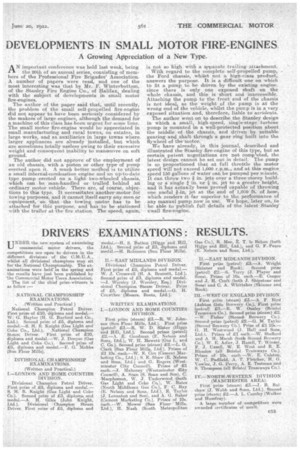DEVELOPMENTS IN SMALL MOTOR FIR.E-ENGINES.
Page 13

If you've noticed an error in this article please click here to report it so we can fix it.
A Growing Appreciation of a New Type.
AN important conference was held last week, being the 20th of an annual series, consisting of members of the Professional Fire Brigades' Association A number of papers were read, and one of the most interesting was that by Mr. F. Winterbottom, of the Stanley Fir e• Engine Co., of Halifax, dealing. with the subject of developments in small motor fire-engines.
The author of the paper said that, until recently, the problem of the small self-propelled fire-engine did not appear to have been seriously considered by the makers of large engines, although the 'demand for a machine of this class has been urgent for some time.
The small motor fire-engine would be appreciated in. small ,manufacturing and rural towns,. on estates, in large works, and as auxiliaries in large towns where. larger appliances are already 'installed, but which are sometimes totally useless owing to their excessive weight and consequent inability to manteuvre on soft ground. The author did not approve of the employment of an old chassis, with a piston or other type of pump
erected upon it A much better •method is to utilize a small internal-corabustion engine and an up-to-da.te type pump erected on .a light two-wheeled chassis, which eau . be man-handled or . trailed behind an:
ordinary motel vehicle. There are, of cOurse, objections to this type. It necessitates .another motor, for
towing purposes, and it cannot itself Garry any mein or equipment, so that --the towing motor has to be attached for thiS purpose, and ha-s to be stationed
• with the trailer at the fire station. The speed, again, is not so high with a separate trailing attachment. With regard, to the complete self-propelled pump, the Ford chassis, whilst not a high-class product, answers the purpose. It is a difficult one on which to fit apump to be driven, by the existing engine, i since there s only one exposed shaft on the whole chassis, and this is short and inaccessible. Attaching the pump to the front end of the chassis is not ideal, as the weight of the pump is at the wrong end of the vehicle, whilst the pump is in a very exposed situation and, therefore, liable to accidents.
The author went on to describe the Stanley design in which a small, high-speed, single-stage turbine pump is mounted in a well-protected position about the middle of the chassis, and driven by suitable gearing and shaft' through a gear ring built into the flywheel of the motor. We have already, in this journal, described and illustrated the" Stanley fire-engine of this type, but as certain patent negotiations are not completed, the latest design cannot be set out in detail. The pump is so proportioned that at full throttle the motor speed will not exceed 1,000 r.p.m., and at this engine _ speed 150 gallons of water can be puniped•per minute. It Can throw two f in. jets over a three-storey building' or a single in. or in. jet to a greater height, and it has actually been proved capable of throwing one aseful jet at the end of 1,000' ft. of hose, which renders it far superior to the performance of any manual pump.now in use. We hope; later on, to be able to' publish fnll details of the latest Stanley Small fire-engine.
































